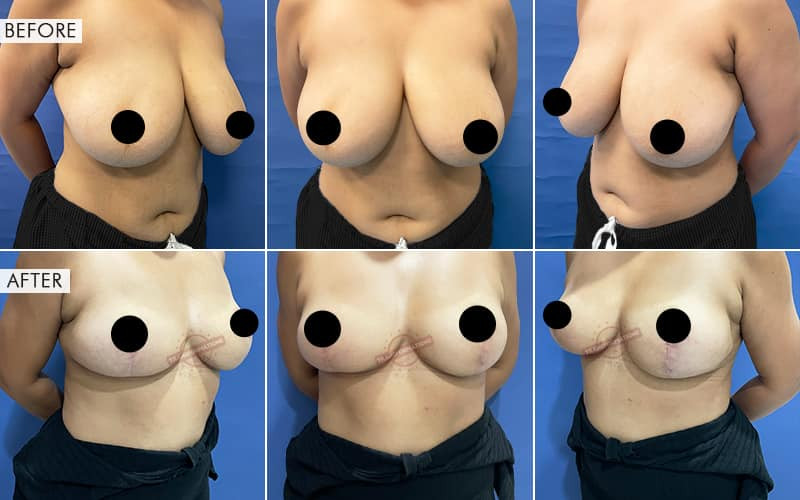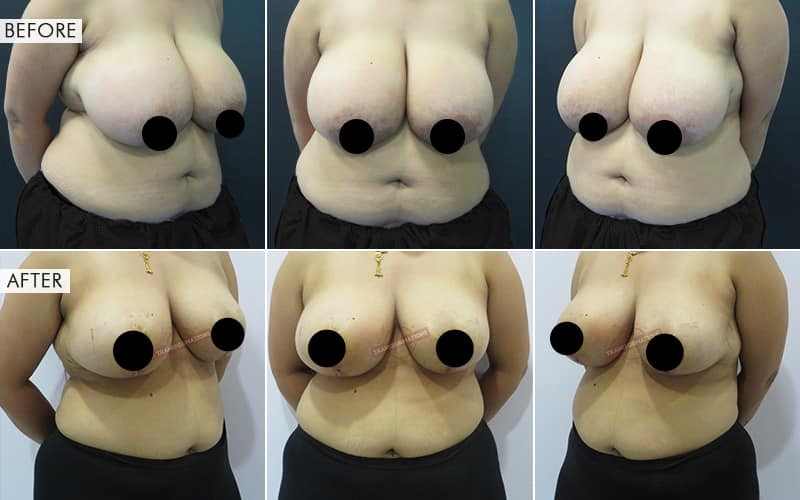Appointment Form
Breas-t Reduction in Dubai, Abu Dhabi
Most women experience saggy breas-ts (medically termed as breas-t ptosis) when they get older. Other than aging, the breas-t may also sag because of gravity, high body mass index, deficiency of collagen and hormone estrogen, menopause, rapid weight fluctuations, multiple pregnancies, and smoking. Some females may also suffer from symptomatic macromastia wherein they develop enlarged breasts. Heavy breasts can lead to pain in the shoulder, back, or neck areas, skin rashes under the breasts, a poor body posture, psychological or emotional discomfort including depression and anxiety, a struggle in finding well-fitting clothes, and even cause troubled breathing. With breas-t reduction surgery performed by an expert plastic and cosmetic surgeon in Abu Dhabi like Dr. Parag Telang one can achieve the desired breas-t shape and best outcomes.
Breas-t reduction (medically termed as reduction mammoplasty) is a cosmetic surgery procedure to reduce the breas-t size, volume, and weight to make it appear smaller, well-shaped, lighter, and uplifted for the long term. It focuses on the removal of surplus breas-t tissues including excess skin and fat and reshaping or raising of dropping nipples to ultimately get an aesthetically pleasing breas-t shape.
Types of surgical procedures performed for breas-t reduction
There are three techniques to perform breas-t reduction which is chosen by the surgeon based on existing breas-t anatomy, the amount and type of breas-t tissues to be removed, and the final desired result.
- Liposuction: It is a minimally invasive, quick, painless procedure to get rid of stubborn fat deposits from the breasts. This method is suitable for people who wish to get slight to moderate breas-t reduction, have mild or no sagging skin to correct, with good skin elasticity, and have enlarged breasts due to excess build-up of fatty tissues. The procedure provides long-lasting results and is associated with virtually undetectable scars.
- Vertical or “Lollipop” breas-t reduction: This procedure provides a satisfactory outcome for individuals who desire to have a moderate breas-t reduction and possess sagging skin. In this type of surgery, the surgeon makes two incisions, one is around the edge of the areola and another is a vertical cut running from the bottom of the areola to the creases beneath the breas-t. Through these incisions, excess fat, breas-t tissue, and skin is removed and the new smaller breas-ts are reshaped internally.
- Inverted-T or “Anchor” breas-t reduction: In this procedure, three incisions are made: one around the areola edge, second from bottom of areola till the breas-t crease, and third is made along the folds underneath the breas-t. With multiple incisions, the surgeon removes more tissues and reshapes them. Thus, this approach is best suited for people who want significant breas-t reduction or have to correct asymmetrical or more sagging breas-ts.
Who are the suitable candidates for breas-t reduction surgery?
People are considered fit for the procedure if they are suffering from the following
- An adult female or male with fully-developed breas-ts, has realistic expectations of the results that can be achieved from surgery. The males can also undergo breast reduction surgery also known as gynecomastia surgery in Dubai performed by Dr. Parag Telang to achieve the desired masculine chest shape.
- Wish to address the improper breas-t size or shape either for cosmetic purposes or comfort reasons i.e. relief from severe back, neck, or shoulder pain and chronic skin irritation underneath the breas-t creases.
If the woman is planning to have a child in future, then the surgery must be postponed as any breas-t changes during pregnancy will reverse the surgical results.
What are the effects of breas-t reduction surgery?
Breas-t reduction surgery offers a lot of benefits, such as
- It can create a more aesthetic breas-t contour that is proportionate to the body.
- It enhances the confidence of individuals who were earlier self-conscious and uncomfortable with their physical appearance.
- It is a relief for all physical and emotional discomforts related to large breas-t size.
- It makes the shopping of clothes and bras easier as breas-ts are made proportional to the body frame, thereby allowing easy and comfortable fitting.
- It can help people work out easily or indulge in any physical activities, exercise, or sports.
- For asthma patients, breas-t reduction surgery can especially improve respiratory function and no longer make them short of breath.
Procedure of breas-t reduction surgery:
1. Initial consultation: A detailed discussion between the patient and Dr. Parag Telang takes place, and this includes a comprehensive discussion about expectations of the patient, risks, and benefits of the procedure, post-procedure, and recovery phase. Dr. Parag Telang, breas-t surgeon in Dubai examines the breas-ts and takes into consideration the following:
- The actual measurements of the breas-ts and assess all the requirements for the surgery. Photographs may be taken for medical records.
- Whether there are any skin issues, cysts, lumps, or nipple discharge that may have affected the breas-ts.
- The medical history and general health of the individual i.e. if there is any current medical illness and any allergies from medications or foods.
- Previous breas-t surgery.
- If there is breas-t cancer history in family.
2. Preparation for breas-t reduction surgery: If the person chooses to proceed with the surgery, then pre-surgery instructions are given. In the days leading to surgery, the following instructions are recommended for the patient (if applicable):
- Smokers must discontinue smoking cigarettes at least 6 weeks before the procedure as it can lead to slow healing and also complications.
- Intake of blood thinning or anti-inflammatory drugs must be ceased one week beforehand.
- A night before the surgery or 6 hours prior to the procedure, the patient must avoid complete filling of the bowel by having heavy food and hard drinks. Up to 2 hours before the admission, the patient is allowed to have small sips of water, black tea, or black coffee.
- Before surgery, the patient must have a baseline mammogram done.
3. Day of the procedure: On the day of surgery, the patient must be present an hour before the scheduled time of surgery so that the healthcare professional can check for the patient vitals, the anaesthesiologist can check and give the patient general anesthesia, and Dr. Parag Telang makes final markups on the breas-t to determine the exact size and position of the breas-ts. The overall procedure may take about 2 to 3 hours.
The surgery involves the following steps
- Making of incision- Based on the type of surgery to be performed and breas-t condition, a pattern of incision is made on the breas-t.
- Removal of extra skin, tissues, or excess fat- Fat is eliminated from the body by liposuction technique while the skin and tissues are surgically excised through the incisions.
- Repositioning of nipples- The nipples are kept preserved on the stalk of breas-t tissue while the operation takes place. After the excess fat, breas-t skin, and tissues are removed, the nipples are relocated at a higher position in accordance with pre-surgical markings. They are usually placed in a level under the breas-t fold or approximately in line with the middle of the arm.
- Closing of incisions- It is done with dissolvable sutures, surgical tapes, or skin adhesives. Lastly, over the suture lines, a light dressing (using a gauze or a bandage) may be applied. Soon after the surgery, drainage tubes may be placed at the incision sites to remove extra fluids or blood.
4. Post-procedure and recovery: Following the surgery, the patient is shifted to a recovery room where the nursing staff would make sure that the patient is conscious and is safe to return home. To go back home, there must be a caretaker for at least 24 hours. For the first few days, the new smaller breas-ts may feel tender and sensitive, and in some cases swollen or bruised. In a matter of days, all the slight discomfort caused by surgery may subside and the patient may return to daily routine after a week of the surgery.
Generally, full recovery may take three to four weeks. The final settled breas-t shape of breas-ts can be seen after 6 weeks of the breas-t reduction which can be confirmed by the final check-up of the surgeon. The breas-ts usually heal at different rates, hence they may appear asymmetrical for the first few months of recovery.
During the recovery period, the patients are advised to follow after-care instructions, such as
- Avoid direct sunlight or UV exposure for 2 to 4 weeks. Wear sunscreen over the surgical scars to prevent its darkening from the sun.
- At least for 6 weeks post-operation, wear a well-fitted, elastic compression bra and avoid any strenuous exercises of the upper body.
- Visit the surgeon after a week of surgery or as suggested by the surgeon to ensure that the surgical site is healing properly.
- Have a healthy balanced diet that is rich in protein to allow quick healing.
- Wear comfy clothing, ideal is the front opening tops.
- Complete the course of antibiotics as prescribed by the doctor. Prescribed pain killers must also be taken to get relief from any discomfort.
Possible risks and complications:
Breas-t reduction surgery must only be performed by qualified and experienced plastic and cosmetic surgeons so that the occurrences of risks are rare. The possible risks include:
- Infection.
- Anesthesia-related side-effects.
- Unwelcomed scarring.
- Asymmetrical locating of nipples.
- Risk of having leg and lung blood clots, pulmonary or cardiac complications.
- Irregular breas-t shape and contour.
- Loss of sensation of breas-t and nipples.
- Excessively firm breas-t.
Choosing the right hospital and the right surgeon plays crucial role in obtaining the desired results and minimising the risks of any complications. A trained anaesthesiologist would know how to nullify the related risks and so would an experienced cosmetic surgeon.
The cost of breas-t reduction surgery in Abu Dhabi and Dubai depends on certain factors like the patient's age, amount of tissue and fat to be removed, type of technique performed, surgeon’s experience, and so on. To know more about breas-t reduction surgery, schedule an appointment with Dr. Parag Telang, the top plastic surgeon in Dubai.
See Latest Results

Breas-t Reduction
✱ Opinion / Results may vary person to person. 
Breas-t Reduction
✱ Opinion / Results may vary person to person. Watch Latest Videos
How Feminising rhinoplasty is different from regular rhinoplasty?
✱ Opinion / Results may vary person to person. Importance of Fat grafting in FFS
✱ Opinion / Results may vary person to person. Testimonials
Dr. Parag telang is the right doctor you should reach out to. He is very professional and gives you the right advice. He is also a very good surgeon and will make sure you are taken care of. I have contacted him for a face surgery and I am recovering well.
✱ Opinion / Results may vary person to person.Dr.Parag Telang is a magician, he does his work beautifully. I would strongly recommend him, one of the best doctor.
✱ Opinion / Results may vary person to person.Dr. Parag Sir is the best cosmetic surgeon in Mumbai. Very happy with the treatment & result. The entire procedure was very comfortable. Didn't experience any pain or discomfort and would recommend to anyone considering cosmetic treatment.!
✱ Opinion / Results may vary person to person.